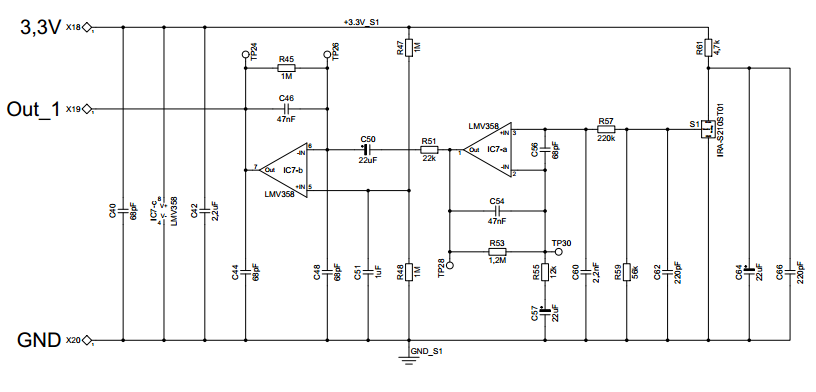Other Parts Discussed in Thread: TINA-TI, LMV324, TLV9002
Hello,
we´re using the LMV358IPWR in many different products as an amplifier for PIR Sensors with an amount of 120k p.a. (Passive Infrared Sensor) Now, we have a noise problem in our applications. About 11% percent of our products fail in the end of line test since 6weeks caused by to high noise.
----------------------------------------------------------------------------------------------------------------------------------------------------------------------------------------------------------------------------------------------------------------------
Explanation to shematic no. 1 below.
Our Problem is a to high Noise in our Application.
We´re talking about an Amplifier for a PIR Sensor. Max Noise of PIR S1, is 20µVpp
Gain of the circuit is approx 3450 at 1Hz. and the Bandwith is 2Hz.
AMP Noise
The max Amp Noise of both Amplifiers + Resistors in the circuit is approx 3,3mV. (Without S2). The result is simulated. But youre able to calculate it manualy with he given typically noise of 37nV/sqrt hz...
PIR Noise
The Noise of the Sensor multiplicated by gain is 69mV.
Complete Noise
SQRT(69mV2 + 3,3mV2) = 69,07mVpp
As you see, the influence of the AMPs Noise is very low. So i thought the problem is caused by the PIR Sensor. But i noticed that nothing happens when i changed the PIR Sensor. But when i solder the AMP to a full working similar PCB (A-B-A swap), the failure occurs at the new PCB. So i think the root cause is the Amp.
The Noise meassured in the circuit at the moment is approx. from 100-250mV. (Maximum calculated is 69,07mV). It occurs in 11% of the AMPs.
The application with this is Amp is used in several of our products without any problem since 2008-09.
So what could be the root cause of the high noise?
Thanks in advance.
Kind Regards.


